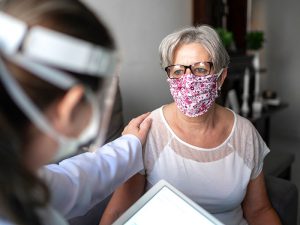When It’s Okay to Delay Medical Care—and When It’s Absolutely Not
COVID-19 worry keeping you from the doctor? Don’t stress. Use this cheat sheet instead.

Are you due to see your doctor but feeling nervous about heading into the office during the pandemic? You’re not alone.
“COVID-19 has made decisions about when and how to get medical care more challenging,” says Bob McNellis, M.P.H., P.A., senior advisor for primary care at the Agency for Healthcare Research and Quality (AHRQ).
According to the Centers for Disease Control and Prevention (CDC), about 32 percent of adults have put off routine medical appointments because of COVID-19 concerns. Even emergency room and urgent care visits are down by 12 percent.
As you might have guessed, there can be serious consequences when people don’t get the healthcare they need. In June 2020, an editorial in Science warned that we’ll see an additional 10,000 deaths from breast and colorectal cancer due to people skipping mammograms and colonoscopies or delaying treatment.
Yes, it’s important to protect yourself from coronavirus, but it’s also important to get the care you need. Here’s when it might be okay to delay medical care—and when it’s not. Plus, learn how to stay connected with your healthcare team and spot the signs of an emergency.
When Should You See Your Doctor?
If you’re in good health with no health risks, you can likely delay routine appointments like physicals, says Andrew Carroll, M.D., a family physician in Chandler, Arizona, and a member of the American Academy of Family Physicians (AAFP) Board of Directors.
But older adults—and anyone with an underlying health condition—should carefully weigh the risks of missing appointments against the benefits of staying home. For example, if you have type 2 diabetes, routine eye exams are essential for catching vision problems early so they’re easier to treat. Other appointments you don’t want to miss include screening tests, vaccinations, and dental care.
“The best place to start is by calling your doctor’s office,” McNellis says. “They can guide you on whether a telehealth visit, an in-person visit, or care at another facility is best for you.”
Keep in mind that medical offices and hospitals are adapting to the times and are doing everything they can to keep you safe and healthy if you do have to come in.
Dr. Carroll has seen family physicians set up outdoor tents in their parking lots to take advantage of the fresh air, which reduces your risk of COVID-19 exposure. And if you need a blood test done, there are even mobile labs that will come to your home to draw blood, he says.
At Dr. Carroll’s office, patients skip the waiting room and go directly into a freshly bleached exam room. His staff books well-patient visits in the morning and visits with sick patients in the afternoon. And everyone wears personal protective equipment (PPE), such as masks.
If you need reassurance, ask your doctor’s office what steps they’re taking to keep you safe. Be sure to also ask what you should do to help yourself and others stay safe.
Take Advantage of Telemedicine
Another way to connect with your healthcare team—while staying safe in your own home—is to use telemedicine or telehealth.
“Most family physicians now offer virtual visits,” says Dr. Carroll. These appointments give your doctor a chance to evaluate how you’re doing, answer any questions you have, and determine if further care is needed. You’d be surprised at how many types of doctor’s appointments can now be done virtually—even eye exams, mole checks, physical therapy, and psychotherapy.
In 2020, Medicare rules were changed so that now telemedicine appointments are covered with fewer restrictions. Before, there were about 13,000 Medicare claims for telemedicine per week. In April, that number skyrocketed to nearly a million per week.
To prepare for a telemedicine appointment, make sure that you have a good internet connection and that your camera and microphone are working properly. Your doctor will send you a link ahead of time, and it’s okay to launch it right away to make sure everything works. Call your doctor’s office if you run into any tech problems.
If you have concerns about privacy, ask your doctor what steps they’re taking to safeguard your telemedicine appointment. And if your living situation is such that you don’t feel comfortable speaking freely, you might want to book an in-person appointment instead.
During the appointment, choose a spot with plenty of light on your face (not behind you), so that your doctor can see you clearly. Take any vitals you can: Weigh yourself, take your temperature, and check your blood pressure, if you have a device at home. Grab all of the medications you’re taking. You can hold up the actual pill bottles to show your doctor.
Subscribe to our newsletter
It's quick and easy. You could be one of the 13 million people who are eligible.
Already a member? Click to discover our 15,000+ participating locations.
Follow Us
And come prepared with a list of questions. The AHRQ offers a free Question Builder app that works on smartphones, laptops, and tablets.
Telemedicine appointments are a “wonderful opportunity,” says Dr. Carroll. “It’s like a house call: We get to help you with your health in the place where you spend the most time.”
Don’t Ignore These Signs of an Emergency
Although no two people are the same, there are certain red-flag symptoms that everyone should take seriously. These include the following:
- Difficulty breathing
- Persistent pain or pressure in the chest
- New confusion
- Inability to wake or stay awake
- Bluish lips or face
- Fainting or sudden dizziness or weakness
- Sudden changes in vision
- Uncontrolled bleeding
- Sudden or severe pain
- Difficulty lifting one arm or suddenly dragging one foot
- Difficulty speaking
- Severe or persistent vomiting or diarrhea
- Coughing or vomiting blood
- Suicidal feelings
Never ignore these symptoms. They could be signs of a serious heart, lung, or neurological problem that needs immediate medical attention, even during the pandemic.
“If you feel that your life is in danger, that’s when you go to an emergency room,” says Dr. Carroll.
Don’t give it a second thought. Emergency rooms and hospitals are taking all necessary precautions to keep you safe from COVID-19 while you’re there.
Take Your Favorite SilverSneakers Classes Online!
SilverSneakers members can access live fitness classes and wellness workshops through SilverSneakers LIVE. See the latest schedule and RSVP for classes here.
Not a member? If you have a Medicare Plan, it may include SilverSneakers—at no additional cost. Check your eligibility instantly here.





